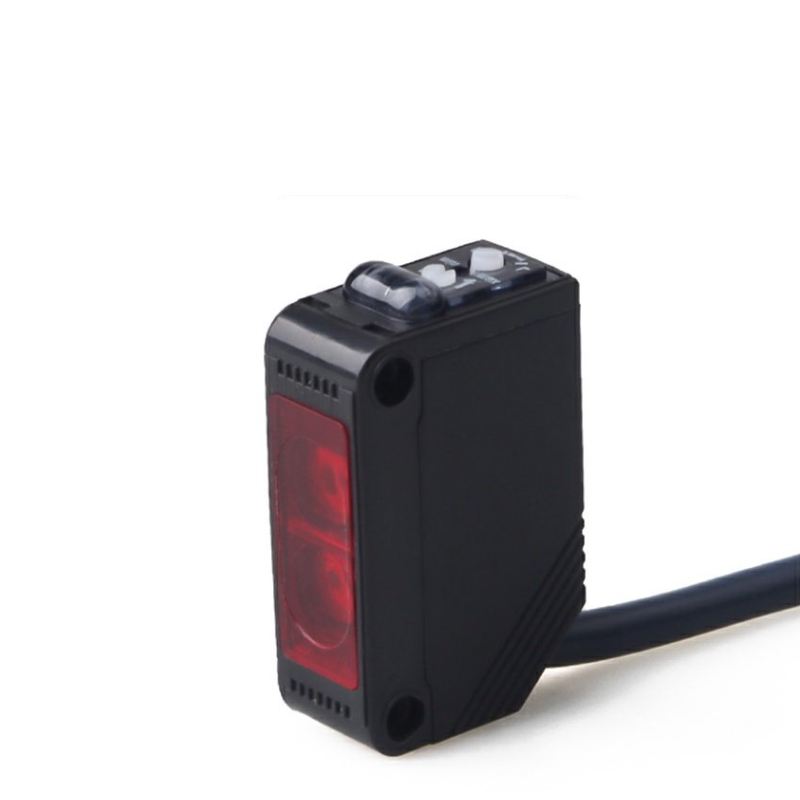Photoelectric sensors have revolutionized industrial automation by providing reliable, non-contact detection capabilities across diverse manufacturing environments. These sophisticated devices utilize light beams to detect the presence, absence, or characteristics of objects without physical contact, making them indispensable components in modern production lines. Their versatility extends from simple proximity detection to complex material sorting applications, establishing them as fundamental building blocks in automated systems worldwide.
Enhanced Detection Accuracy and Reliability
Precision Object Detection
The primary advantage of photoelectric sensors lies in their exceptional detection accuracy, which surpasses traditional mechanical switches and proximity sensors. These devices can detect objects as small as 0.1mm in diameter while maintaining consistent performance across varying environmental conditions. The optical detection method eliminates the mechanical wear associated with contact-based sensors, ensuring long-term reliability in demanding industrial applications.
Modern photoelectric sensors incorporate advanced signal processing algorithms that filter out ambient light interference and electrical noise. This technological advancement enables precise detection even in challenging environments with fluctuating lighting conditions or electromagnetic interference. The result is a detection system that maintains accuracy rates exceeding 99.9% in typical industrial applications.

Consistent Performance Across Materials
Unlike inductive or capacitive sensors that are limited to specific material types, photoelectric sensors demonstrate remarkable versatility in detecting various objects regardless of their composition. Whether dealing with metallic components, plastic parts, glass surfaces, or organic materials, these sensors provide consistent detection capabilities. This material independence makes them ideal for mixed-material production lines where different product types share the same detection system.
The ability to detect transparent and translucent materials represents another significant advantage of photoelectric sensors. Traditional proximity sensors often struggle with glass or clear plastic detection, but optical sensors can be configured to detect even highly transparent materials through specialized beam configurations and sensitivity adjustments.
Versatile Detection Methods and Configurations
Multiple Sensing Modes
Photoelectric sensors offer three primary detection modes: through-beam, retro-reflective, and diffuse reflective sensing. Through-beam sensors provide the longest detection range and highest accuracy by positioning the transmitter and receiver in separate housings. This configuration excels in applications requiring detection across conveyor systems or production gaps where maximum reliability is essential.
Retro-reflective sensors combine transmitter and receiver in a single housing while utilizing a reflector to bounce the light beam back to the sensor. This configuration simplifies installation while maintaining excellent detection range and accuracy. The single-housing design reduces wiring complexity and installation time, making it cost-effective for many industrial applications.
Customizable Detection Parameters
Modern photoelectric sensors feature adjustable sensitivity settings that allow operators to fine-tune detection parameters for specific applications. These adjustments enable optimal performance across varying object sizes, colors, and surface finishes. The ability to customize detection thresholds ensures reliable operation while minimizing false triggers from environmental factors.
Advanced models incorporate multi-function capabilities, allowing users to switch between different sensing modes or adjust timing parameters through simple programming interfaces. This flexibility eliminates the need for multiple sensor types in complex applications, reducing inventory costs and simplifying maintenance procedures.
Superior Environmental Resistance
Harsh Environment Operation
Industrial photoelectric sensors are engineered to withstand extreme environmental conditions that would compromise other detection technologies. Their sealed optical systems resist contamination from dust, dirt, and liquid splashes, maintaining consistent performance in harsh manufacturing environments. Many models feature IP67 or IP69K ratings, ensuring reliable operation in washdown applications and outdoor installations.
Temperature stability represents another crucial advantage, with quality photoelectric sensors operating reliably across temperature ranges from -40°C to +70°C. This thermal resilience enables deployment in diverse industrial settings, from cold storage facilities to hot manufacturing processes, without performance degradation or frequent recalibration requirements.
Chemical and Corrosion Resistance
The non-contact nature of photoelectric sensors eliminates exposure to corrosive chemicals that might damage mechanical components in traditional sensors. The optical detection method remains unaffected by acidic or alkaline environments, making these sensors ideal for chemical processing, food production, and pharmaceutical manufacturing applications where chemical resistance is paramount.
Specialized housing materials and protective coatings further enhance chemical resistance, allowing photoelectric sensors to operate in aggressive environments where other sensor technologies would fail. This durability translates to reduced maintenance costs and extended service life in challenging industrial applications.
Cost-Effective Installation and Maintenance
Simplified Wiring and Setup
Photoelectric sensors typically require only basic electrical connections, simplifying installation compared to complex sensor systems. Most models operate on standard 12-24V DC or 24-240V AC power supplies, integrating seamlessly with existing control systems. The straightforward wiring requirements reduce installation time and minimize the potential for connection errors during setup.
Many modern photoelectric sensors feature plug-and-play connectivity with standardized M12 or M8 connectors, further streamlining installation processes. These standardized connections ensure reliable electrical contact while enabling quick sensor replacement during maintenance activities. The modular approach reduces system downtime and simplifies troubleshooting procedures.
Minimal Maintenance Requirements
The absence of moving parts in photoelectric sensors significantly reduces maintenance requirements compared to mechanical detection systems. Regular cleaning of optical surfaces represents the primary maintenance activity, typically performed during scheduled equipment inspections. This minimal maintenance approach reduces operational costs and maximizes equipment availability.
Self-diagnostic features in advanced photoelectric sensors provide real-time performance monitoring, alerting operators to potential issues before complete failure occurs. These predictive maintenance capabilities enable proactive sensor replacement, preventing unexpected production interruptions and optimizing maintenance scheduling.
High-Speed Detection Capabilities
Rapid Response Times
Photoelectric sensors excel in high-speed applications due to their electronic switching characteristics, achieving response times as fast as 50 microseconds. This rapid response capability enables detection of fast-moving objects on high-speed production lines without missing counts or triggering delays. The electronic nature of the detection process eliminates mechanical bounce and switching delays associated with traditional sensors.
The high-frequency switching capability of photoelectric sensors supports applications requiring precise timing control, such as synchronized conveyor systems or high-speed sorting equipment. This temporal accuracy enables complex automation sequences that demand precise object positioning and timing coordination.
Extended Detection Ranges
Depending on configuration and model selection, photoelectric sensors can achieve detection ranges from millimeters to several meters. Through-beam configurations offer the longest ranges, supporting applications across wide conveyor systems or large machinery installations. This range flexibility eliminates the need for multiple sensor technologies in applications with varying detection distance requirements.
The extended range capability proves particularly valuable in safety applications where photoelectric sensors create light curtains or area protection systems. These safety implementations protect personnel while maintaining productivity in automated manufacturing environments.
FAQ
What factors should be considered when selecting photoelectric sensors for industrial applications?
Key selection factors include detection range requirements, object characteristics (size, color, material), environmental conditions (temperature, humidity, contamination), and response time specifications. Consider the sensing mode that best fits your application geometry and whether special features like background suppression or polarized light filtering are necessary for reliable operation.
How do photoelectric sensors compare to other detection technologies in terms of accuracy?
Photoelectric sensors typically offer superior accuracy compared to inductive or capacitive sensors, especially for precise positioning applications. Their non-contact optical detection method provides consistent repeatability within ±0.1mm for quality models, while their material independence ensures reliable detection across diverse object types without sensitivity variations.
What maintenance procedures are required to ensure optimal photoelectric sensor performance?
Primary maintenance involves periodic cleaning of optical surfaces using appropriate solvents and lint-free cloths to remove dust, oil, or other contaminants. Regular inspection of electrical connections and housing integrity should be performed according to manufacturer recommendations. Most quality photoelectric sensors require minimal maintenance due to their solid-state construction and sealed optical systems.
Can photoelectric sensors operate reliably in outdoor or harsh industrial environments?
Yes, industrial-grade photoelectric sensors are specifically designed for harsh environment operation with appropriate IP ratings for dust and moisture protection. Models with IP67 or higher ratings can withstand direct water spray and dust exposure while maintaining consistent performance across wide temperature ranges. Proper housing selection and installation practices ensure reliable outdoor operation in most industrial applications.
Table of Contents
- Enhanced Detection Accuracy and Reliability
- Versatile Detection Methods and Configurations
- Superior Environmental Resistance
- Cost-Effective Installation and Maintenance
- High-Speed Detection Capabilities
-
FAQ
- What factors should be considered when selecting photoelectric sensors for industrial applications?
- How do photoelectric sensors compare to other detection technologies in terms of accuracy?
- What maintenance procedures are required to ensure optimal photoelectric sensor performance?
- Can photoelectric sensors operate reliably in outdoor or harsh industrial environments?

